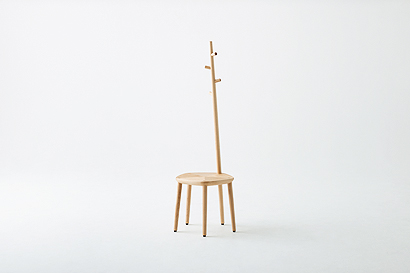|
Each piece is based on a rounded pentagon (Images: Takimi Ota) |
||
|
Matsuso T’s Japanese-Swedish collaboration has resulted in a finely crafted, if occasionally eccentric, range of pentagonal wood furniture The Five furniture collection by Claesson Koivisto Rune for Matsuso T is filled with odd nuances. A stool extends a branch-like arm from the top of one its five legs. Vibrant red indentations dot many of the light maple wood surfaces, yet others are coloured entirely red. And the shape that occurs in almost all of the pieces is an unusual combination of a pentagon and a circle. The offbeat collection is a mix of Eastern and Western influences. Matsuso T, a brand curated by Japanese designer Jin Kuramoto, brings together two Japanese companies with a history of fine craftsmanship: Matsuso and Takahashi. Claesson Koivisto Rune is a Stockholm-based studio whose expertise Kuramoto sought out; he met them seven years earlier when he was fresh out of college. Combined with an encouraging nudge from the Japan Brand – a Japanese governmental initiative to boost the export market – Kuramoto had a dream team on his hands.
The collection is made from a light maple wood “Normally you work with low-tech companies trying to do high-tech furniture,” Ola Rune says. “At Matsuso T, they are able to do beautiful craftsmanship. We would never dream of asking a regular company to do this kind of work.” Five’s chair is an example of the “kind of work” Rune speaks about. Two of the chair’s four legs stand proudly at the front, while the back two slant forwards. Rising up through precise holes in the seat, their ends meet the curved back and arm rest. A fifth “leg” supports the chair’s back. Even though Rune cites the chair as the most challenging of the series, for the first time Claesson Koivisto Rune didn’t have to change anything from the prototype to the finished piece. The high gloss of the furniture was something of an achievement. The original plan had been to employ the traditional urushi technique, whereby multiple layers of paint are applied to a surface for a highly glossed, durable finish. Rune says, “The process takes three months and with a cost of about £25,000 a piece, it just wasn’t feasible.” Instead, the craftsmen came up with a solution of treating the wood and lacquering the surface with a thin tainted varnish. “The effect is something between transparent and high gloss paint where the grain of the wood is still visible. I’ve never seen anything like it.” Japanese references frequent the collection in subtle flourishes. That vibrant red is vermilion, the same shade used in shrines and temples in Japan, while the shape of the minimal coat rail – a straight wooden slat with angled ends, hung by two red strings – refers to traditional hangers used for kimonos. Aesthetically, the coat rail is quite removed from the pentagonal shape of the other furniture. Rune explains: “The look is different, it’s a bit more playful, but it shares a connection as a side of the pentagon.” Five is a little odd, but endearingly so.
The fifth leg of the stool extends like a branch |
Words Enya Moore |
|
|
||
|
Vermillion is used throughout the collection |
||






















